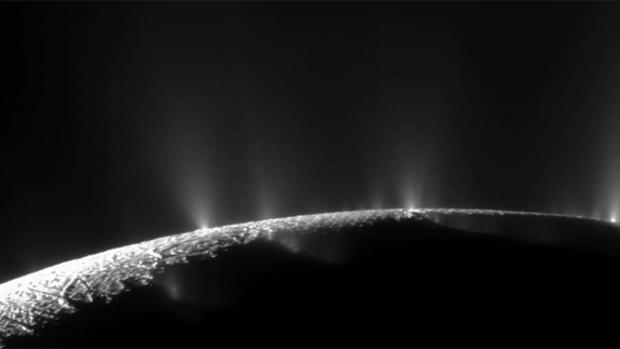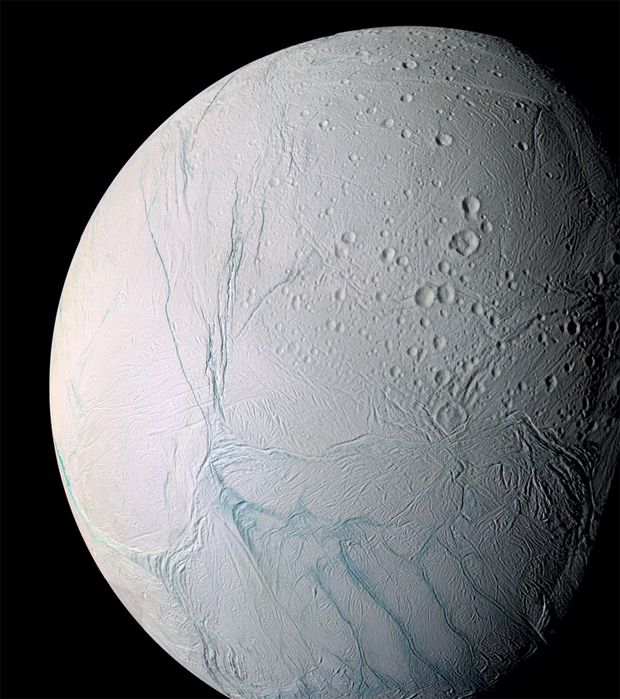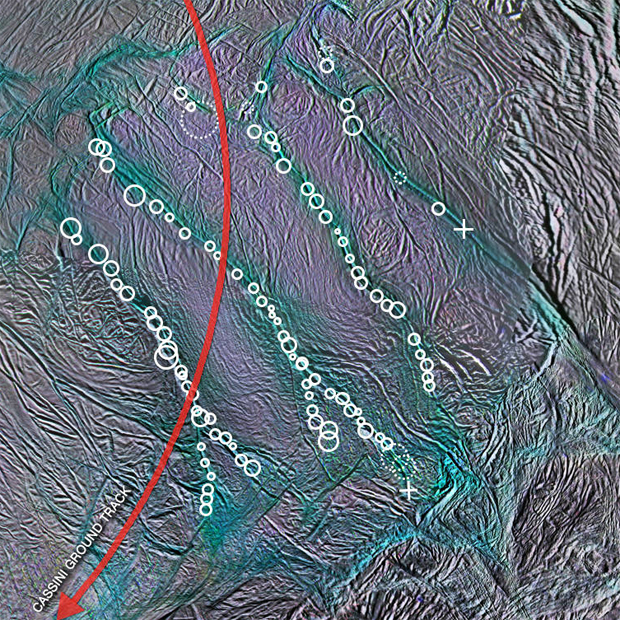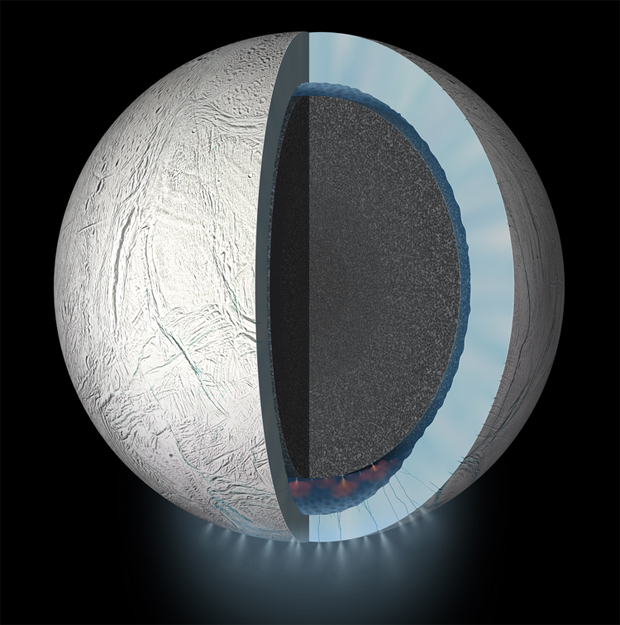Cassini on track to fly through geyser-like plumes of Saturn's moon Enceladus
Streaking through space at 19,000 mph, NASA's Cassini probe will pass just 30 miles above the south pole of Saturn's moon Enceladus Wednesday, flying through tenuous geyser-like plumes of ice, water vapor and organic compounds spewing from a vast sub-surface ocean through cracks in the moon's icy crust.
Cassini discovered the plumes in 2005 and after repeated flybys, careful analysis has confirmed the presence of a global, slightly salty ocean below the moon's crust, warmed by gravitational tides and possibly habitable to life as it is known on Earth.
While this will be the 21st flyby of Enceladus since Cassini braked into orbit around Saturn in 2004, it will be the first time the spacecraft has flown through the enigmatic plumes at such a low altitude, giving its instruments a denser broth to sample.
"We're going to be screaming over the south pole at around 19,000 miles per hour, just 30 miles above the surface, and we're going to go right through the plume," said Earl Maize, Cassini project manager at the Jet Propulsion Laboratory in Pasadena, Calif.
Given the spacecraft's high speed, the plume fly through will be "over in an instant," Maize said, but that will be more than enough time for Cassini's ion and neutral mass spectrometer to look for molecular hydrogen from hydrothermal vents on the hidden seabed while its dust analyzer studies the chemistry of the materials in the icy spray.
The plumes originate in long crack-like fissures known as "tiger stripes," but it's not yet clear whether the sprays erupt in isolated column-like jets or in long "curtains" like some lava flows seen on Earth. No such plumes are seen at the north pole of Enceladus.
"Underneath the crust, there is an ocean, and that ocean is spewing up plumes at the south pole of Enceladus and one of the most interesting things about those plumes is that they have organic material in them, pre-biotic material," Bonnie Buratti, leader of the Cassini project's icy moons working group, said in an interview.
"So under the south pole of Enceladus, we have what astronomers and geologists call a habitable zone. It is an area where the potential for life -- and I have to emphasize, we haven't found life -- but the potential for life evolving is there. Because it has all the requirements: it has liquid water, which we need for life as we know it, there's food, which is the organic volatiles we've found, and then there's a source of energy, which we think is tidal energy."
Curt Niebur, Cassini program scientist at NASA Headquarters in Washington, said water worlds like Enceladus and Jupiter's large moon Europa could offer profound insights into the nature of habitable environments and the likelihood of life across the galaxy.
"While the Cassini spacecraft does not have the instruments needed to detect life, it does have the instruments that can tell us about the characteristics of that ocean," he said. "It is those characteristics that control habitability, that control whether or not life on Enceladus is even a remote possibility.
"On Wednesday, we will plunge deeper into that magnificent plume coming from the south pole than we ever have before, and we will collect the best samples ever from an ocean beyond Earth."
Maize said Cassini's cameras will be shooting the surface during the approach and then as the spacecraft departs. But the north pole of Enceladus is currently in sunlight, so the south polar region will be illuminated primarily by reflected light from Saturn.
Given Cassini's high velocity and low altitude, images captured around close approach are expected to be blurred, or "smeared." But with computer processing, researchers expect to clean up the photographs, providing the best views yet of the tiger stripes where the plumes originate.
Maize said the first images should get back to Earth late Wednesday, but it will take a day or so to process the files. Data from the dust analyzer and spectrometer will take longer to analyze.
Asked about the danger posed by passing through the plumes at high speed, Maize said material is so tenuous it will be like flying through fog or steam, adding the science payoff is well worth the slightly elevated risk.
"Enceladus has surprised us every time," he said in an interview with CBS News. "Who would have thought a 250-kilometer radius rock would actually have active cryovolcanism on it, an active liquid sub-polar ocean and now we're seeing signs of thermodynamics. It's just too tempting a target to pass up.
"We'll be going through smoke, essentially, and we're going fast, but most of the particles are really quite small and the instruments are built to handle that sort of thing."
After a flyby of Titan on Nov. 12, Cassini will carry out its 22nd and final close encounter with Enceladus on Dec. 19, passing within about 3,100 miles of the surface to study the south polar region in a broader context.
At that point, the focus of the mission will shift to repeated flybys of Titan to steeply tilt Cassini's orbit, setting up 22 dramatic passes between the planet's innermost rings and the top of its discernible atmosphere. Finally, on Sept. 15, 2017, Cassini will plunge into the cloudtops, bringing one of NASA's most successful missions to a close.
"We'll look at the planet's gravity and magnetic fields in exquisite detail, measure the mass of the rings for the very first time, get in situ measurements that will directly measure the composition of the ring particles as well as tell us about the composition of Saturn's upper atmosphere," said Linda Spilker, Cassini project scientist at JPL.
"Then on our final orbit, Cassini will go out in what I call a blaze of glory as we go into Saturn's atmosphere, and at that point the spacecraft itself will be vaporized. You can imagine all the molecules of Cassini being spread across and being part of Saturn itself."
Launched in October 1997, Cassini arrived at Saturn in July 2004 and dropped off a lander built by the European Space Agency that successfully completed a parachute descent to the surface of Titan the following January.
Since then, Cassini has flown through a complex set of ever-changing orbits to make repeated flybys of Saturn, its huge ring system and many of its moons, earning two mission extensions in the process.
The final two Enceladus flybys come as flight controllers begin a series of precisely choreographed rocket firings to set up close encounters with Titan that will gravitationally bend the spacecraft's trajectory into a near-polar orbit.
"If you think about what we do at Saturn, all of the (rocket) burns, all they do is set up a (gravitational) slingshot with Titan," Maize said. "Everything that's done is done by Titan. So the big burns, they're going to set us up so when we fly by Titan we'll start to crank up our orbit, incline us more and more (relative to Saturn's equator).
"We begin that in January and for the next 10 months after that, we'll keep climbing in inclination using Titan. And those big burns set up that set of encounters."
Maize said Cassini remains in remarkably good health with all but one of its instruments operating in normal or near-normal fashion.
"The spacecraft's a trooper," he said. "It is absolutely still performing marvelously. We've got some creaky parts, as you can imagine, after 11 years in orbit and almost 17 years since launch. But it's still performing very, very well. We've lost one instrument, one of our plasma instruments has failed, but everything else is going along just fine. We're getting a full suite of science."
Two of the spacecraft's four "reaction wheels" -- three at a time are used to precisely orient the probe by changing how fast they spin -- are showing signs of wear and tear and one of them has been "retired." But it can be put back into service if required.
The major concern going into the final two years of Cassini's mission is the amount of propellant left on board.
"We're really low," Maize said. "The next (few) months are really going to tell us how it's going to be for the rest of the mission. In December and January we've got some big burns coming up and if we get through those with some fuel left in the tank, we are home free."
If not, engineers will resort to plan B, using smaller thrusters and a different propellant system to set up the Titan encounters, an option that would "be a bit more stressful on both the flight team and the system," Maize said.
But engineers are optimistic enough propellant remains to get the job done as planned.
"The issue we worry about is what if we mis-estimated, if we have a little bit less than we think? We always have to manage the downside, so we'e going to worry," Maize said. "We'll worry all the way through until March, in which case we'll be completely home free. But the big burns in December and January are doing to (get) a lot of attention."





